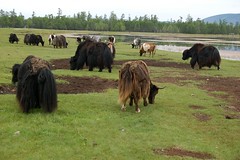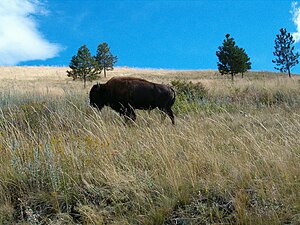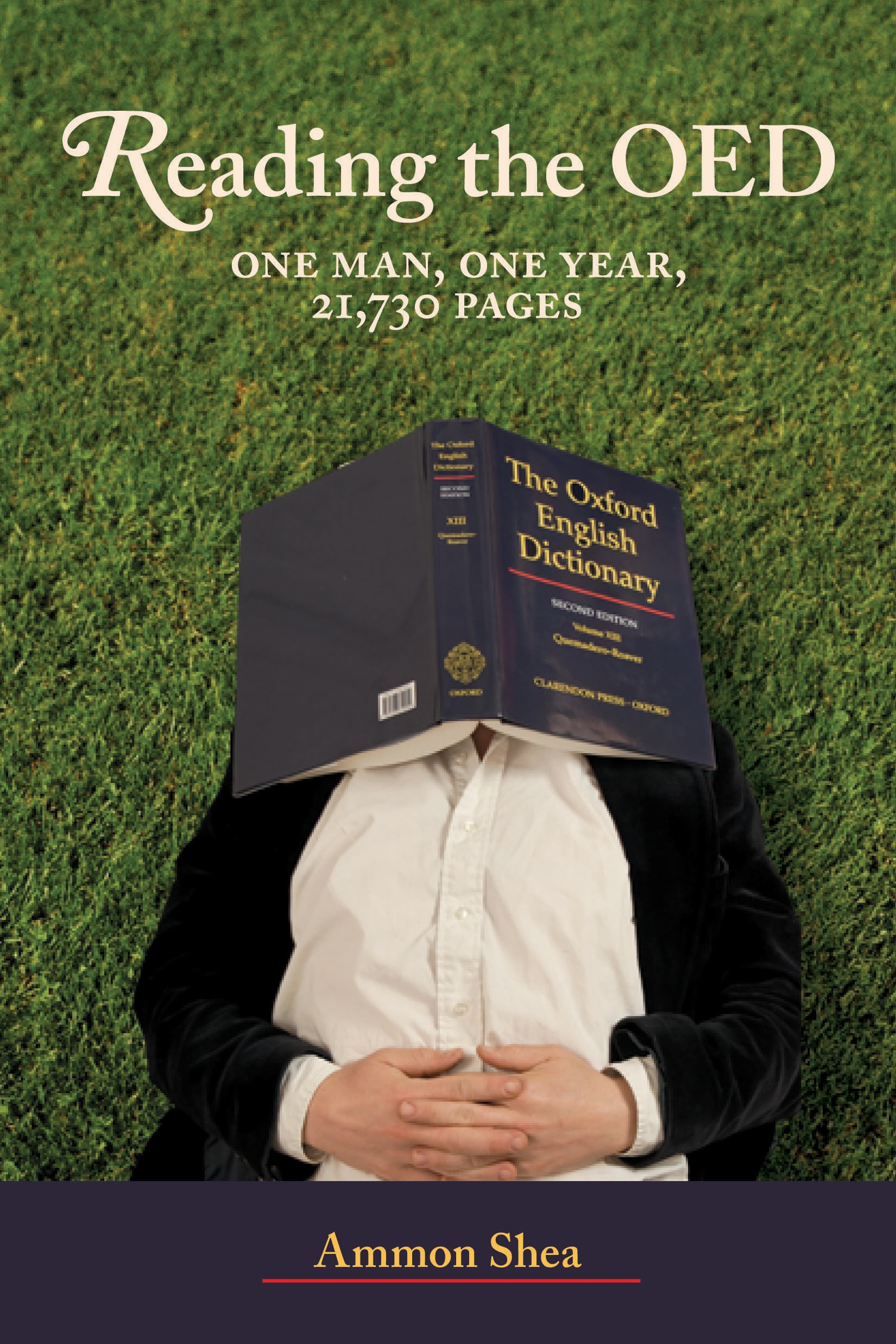ऐतिहासिक सड़क जाम कुछ समय पर गुडगांव नाम परिवर्तन के लिए सुर्खियों मे रहा था और आज एतिहासिक जाम के लिए गुरुग्राम ने सुर्खिया बटोरी. ट्विटर यूजर्स ने फोटो पोस्ट करते हुए लिखा कि एक दिन में गुड़गांव वेनिस बन गया. गुड़गांव में शाम 4 बजे के आसपास तेज बारिश के बाद भयंकर और एतिहासिक […]
The post ऐतिहासिक सड़क जाम appeared first on Monica Gupta.

Yaks! (Photo credit: bdearth)
Yes, we are having a heat wave here in NW Montana. It hit 87° F. here today while we were out on photo safari. That’s rare for mid-May up here.
Today’s safari took us to places we don’t frequent often, to see what was available for the lens and the Muse. We visited The Garden of the Thousand Buddha’s down in Arlee before moving west. It’s a Buddhist temple area sitting on the Flathead Indian Reservation. The Garden is coming along, though inclement weather isn’t doing it any favors in exposed areas around the central huge Buddha.

A bison roaming about at the National Bison Range in Montana (Photo credit: Wikipedia)
Most people suspect that we have bison ranches. In fact, we have the National Bison Range just southwest of the town of Charlo. Did you know that we have ranches running musk oxen and yak? Yep. We scouted out one such ranch down in the Camas Prairie area of Sanders County.
Along the way, we picnicked along the Flathead River and watched kayakers braving deep spring run-off waters. Osprey fished along those same turquoise waters, daring bald eagles to infringe on nesting territories.
Squirrels warned off those who came too close and pileated woodpeckers took their time with smaller trees a few yards from the car. Young quaking aspens waved at us, not having aged enough to rustle in the breeze. Smoke from a suspected new wild fire in the mountain range south of Highway 200 filled the valley with tension; not uncommon, merely early in the season.
Overall, it was a good day.

Nordhielm Wooldridge, Connie. (2011) Just Fine the Way They Are: From Dirt Roads to Rail Roads to Interstates. Honesdale, PA: Calkins Creek of Boyds Mill Press. ISBN 978-1-59078-710-6. (26 pgs) Author recommends grades 4-6; Litland adds excellent for younger advanced readers.
Publisher’s Description: Change. Who needs it? We do! Mr. John Slack, the keeper of a tavern beside a rutted dirt road in the early 1800s, thought things were just fine the way they were. So did Lucius Stockton who ran the National Road Stage Company in the mid 1800s. So too, did the owners of the railroads when the first model T appeared in 1908. Yet with each new innovation, Americans were able to move around the country more quickly, efficiently, and comfortably. Connie Woolbridge offers an informative, yet light-hearted look at how the dirt roads of the early 1800s evolved into the present-day U.S. highway system. Richard Walz’s gorgeous paintings capture both the broad sweep and the individual impact of change and progress.
Our thoughts:
What a great overview of American history focused on transportation! Told in a folky style, the narrator’s storytelling voice reminds us of sitting on the front porch and listening to elders of the family recount the same stories over and over again. And even though we already knew the story, we enjoyed hearing it once more. Only for 8-11 year olds, these stories will be new :>)
Just Fine the Way They Are has lots of potential uses:
* reluctant readers, particularly boys, will find an easy and entertaining style holding their attention.
* a discussion tool for talking about feelings or conflict, making it great for family book clubs or class discussions.
* illustrations are brilliantly eye-catching—I was sitting in a diner reading this, and the waitress walked over saying “What a cute book!”. As such, it would surely keep the students’ attention if read to the class, whether reading to a traditional classroom or homeschool kids around the dining table.
* While intended for 4th, 5th & 6th grades, it also would be great for accelerated students writing their first book report.
An added touch: it comes complete with a historic timeline, bibliography, and list of relevant websites. Plus the author (a former elementary school librarian) has lesson plans on her website too (see http://conniewooldridge.com/ )! This is one of those unique books that provide diversity on the bookshelf, catching the eye of the reader looking for something a bit different, and being enjoyed many times over :>) Pick up a copy at our Litland.com Bookstore!
 Ammon Shea recently spent a year of his life reading the OED from start to finish. Over the next few months he will be posting weekly blogs about the insights, gems, and thoughts on language that came from this experience. His book, Reading the OED, will be published by Perigee in July. In the post below Ammon, an expert dictionary reader, reflects on rain.
Ammon Shea recently spent a year of his life reading the OED from start to finish. Over the next few months he will be posting weekly blogs about the insights, gems, and thoughts on language that came from this experience. His book, Reading the OED, will be published by Perigee in July. In the post below Ammon, an expert dictionary reader, reflects on rain.
My girlfriend Alix and I are driving across the country, as people are occasionally wont to do. I know that this particularly American rite of passage is not uncommon but it is one that I have never completed. And so even though we are not in fact driving all the way across I am nonetheless quite excited.
The weather is quite excited as well, and it chooses to make apparent this excitement by raining almost continuously as we’ve driven south and west. I love the rain, and mind its on and off-again exuberance not at all. Each fresh storm that we drive into reminds me of just how sodden English is with its own words for rain.
There are small clutches of largely archaic Scottish words that can describe a different kind of rain, and can be so much more specific than simply relying on drizzle/rain/downpour. There are words such as blirts (’a short dash of rain coming with a gust of wind’), bracks (’a sudden heavy fall of rain’), and driffle (’to rain fitfully…as at the “tail” of a shower’).
There are words for things that have been wet with rain (impluvious), and words that can describe the drip of your clothes when you’ve gotten soaked (platch).
Driving down the highway there is evidence of the rain everywhere, even in those few intervals between showers (also know as hot gleams). The clouds ahead that are dark and ponderous are imbriferous (rain-bringing) and the cars that approach on the other side of the highway and have just passed out of a storm of their own are bedrabbled (made wet or dirty with rain and mud).
There are rain words whose main function is not to describe something, but rather to arouse a vocabularian sense of whimsy, such as hyetal (of or belonging to rain).
I am sure that has hyetal many fine technical uses, but whenever I think of it I simply wonder what sort of things belong to the rain and if the rain ever gets tired of owning them.
My favorite world for rain is the one that comes to mind when we take advantage of a pluvial lull, and stop driving. When we get out of the car the smell of freshly fallen rain rising off the sidewalk and the word that describes this smell inextricably link themselves in my brain–petrichor–and I cannot tell if the word makes me like the smell or the smell makes me like the word or if it matters at all.
ShareThis







We have feral wallabies in Kalihi Valley very close to where I live. Exotic (non-native) birds abound here as well. Fun, isn’t it. One Hawaii Island there is a llama ranch. The Hawaiian equivalent to ranch-house-place etc is hale (ha-lay). So of course, the owners named their place Hale Llama (Dali Lama). I love fun nerdy facts. Seems as if I need to stop by again tomorrow to see what Meena Rose has in store!
Claudsy,
As a city slicker, you have given me such an intimate glimpse of the outdoors! Very engaging. You have given me much to yack about
Meena
Hale Llama is too funny. I once shaved my head completely for a fundraiser. As my hair was growing in, I earned the nickname Dali Mama. See you tomorrow, Lara.
Til then.
I’m glad you enjoyed “tripping” with me, Lara. It was a good day, but exhausting, in it’s own way. We drove about 250 miles, all totaled. Exotics abound in this state and in many others. I’ve never met a wallaby; in the wild, that is. I can’t imagine llamas in the tropics, either.
We all have regional oddities that can play with the mind and our writing projects. Perhaps I should begin a project that asks for… I’ll have to think about it and get back to you.
Please do stop by for Meena’s post. You’re gonna love it. Really!
Meena, Sister is going to be posting some of the photos she took today in an album on her FB page in the next couple of days, probably. You can check them out on https://www.facebook.com/pages/BJJones-Photography/228417527189794/
Be sure and say hello for me. You’ll enjoy them.
Somehow, I never think of you yacking, only being a deer.
I can’t imagine not loving it.
Factoid: Hawaii Island aka The Big Island is big. So where the llamas are on top of Kohala Ridge, the altitude and the sea breezes make for some comfortable llamas.
That would make sense, since they get snow there. I’m glad to hear that, Lara. It’s amazing what we learn just from a simple post, isn’t it?
Yea, they get snow over on Mauna Kea where the space observatory is located. That’s even higher up. The Big Island is made up of 5 (I think) extinct, dormant and active volcanoes. Mauna Loa is still active of course with Kilauea crater and Hale Maumau.
It sounds like a wonderful place to live.
Yeah, it is, Val. It’s quiet most of the time and we never go a week without learning something new and different. The air is clean, except during fire season, the waiters are clear, except when during spring flooding. And people are friendly. It’s a good life here.